585
From the distant future: top 10 physics predictions for 2016
Science is a wonderful tool for future predictions. And that's what we should bring next year.
"The last words of the year belong to the last voice. Words new year await another voice." Thomas Eliot

2015 in science were very significant here for the following reasons:
— The large Hadron Collider (LHC) has reached the highest levels of energy in history
— scientists found evidence of water on the surface of Mars,
— confirmed one of the last great predictions of the Big Bang — the cosmic background radiation, neutrinos, and even measured its temperature,
— open a huge number of exoplanets that have further enhanced our expectations for the search for life in the Universe.
But we all know best, of course, in front, and 2016 promises even more new facts about the Universe. We can say with even more certainty that, if You read the various pseudo-scientific press, you will see a huge number of predictions that will never become reality!
And so, without superfluous noise and a dust, here in front of you 10 stories — my (approx. pens. — Ethan Siegel!) predictions of what we will see next year — with commentary, how likely is it that this event will occur in reality.
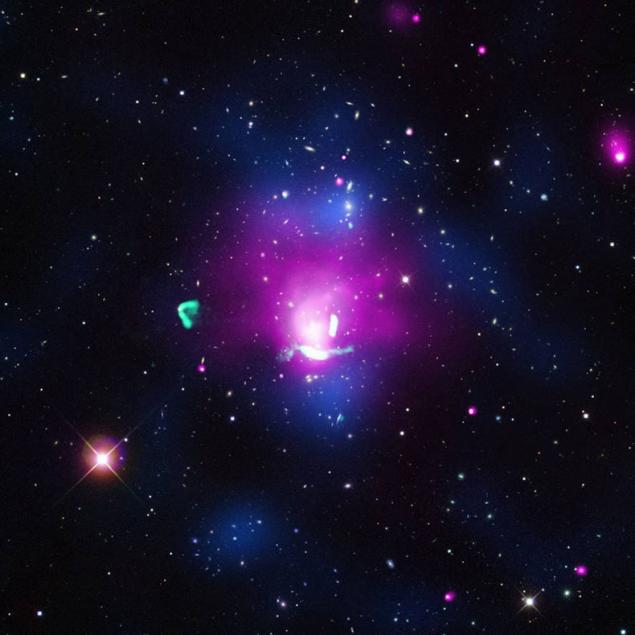
Image credit: X-ray: NASA/CXC/Univ of Hamburg/F. de Gasperin et al; Optical: SDSS; Radio: NRAO/VLA.
1. Experiments to detect dark matter will set a new distance record
Direct detection of dark matter — something like the "Holy Grail" of physicists. Several teams of scientists — for example, XENON, LUX, CDMS and ADMX are chasing dark matter or watching its collision with ordinary matter or trying to force her to interact with electromagnetic forces with the emission or annihilation of photons. Other, indirect methods have made it possible to observe dark matter — for example, in collisions of massive clusters of galaxies, but direct observations have not yet been.
Experiments like DAMA and CoGENT has detected an annual modulation in the number of interactions between particles. However, this result can be explained by the influence of certain other factors, not dark matter. While our experiments impose greater constraints on dark matter. I think that these restrictions will only increase and, most likely, we will not be able to directly detect dark matter in 2016м.

Image credit: E. Siegel, from his new book, Beyond The Galaxy.
2) Physics LHC will find at least 3 new particles... which are not particles!
The standard model of elementary particles is very good. Very very good. Too good — in the sense that when we study the results of collisions of particles, how they interact and decay, to explain what is happening to us required nothing more than the Standard model. And this is a problem for all extensions that currently exist, including the multiplicity of dimensions, supersymmetry, Technicolor or string theory. It is also a problem and dark matter if we ever wish to find in the lab.
In a perfect world we should open with a TANK of new fundamental particles. In particle physics the "gold standard" for discovery is 5σ, but the situation is so awful that it is reported on particles of 3.3 σ, 2.5 σ and 1.9 σ or even! Almost certainly this is not a real particle, and fluctuations. These kinds of messages we call "grasping at straws", this is evidence that we haven't found anything. I suppose at the LHC we won't find anything new, but messages about discoveries will continue to appear as if they are real particles, not speculative results based on fantasies... at least three times next year!

Image credit: NASA, via mars.nasa.gov/allaboutmars/extreme/quickfacts/.
3) In may 2016 Mars will come into opposition, and the media will again have a noise that he "size of the moon"
No, Mars will not be visible size of the moon — not now, not when it reaches opposition, never in the history of the Solar System. The reality is still incredibly interesting — Mars, unlike all the other planets, a huge difference in the distances of the different oppositions — from 56 million km in 2018 to 102 million km in 2027. But it is clear that it is not interesting for many people.
And all because the orbit of Mars is elliptical, which in combination with the orbit of the Earth leads to the fact that "close" the opposition seem to be 5 times brighter and at least 2 times more than "distant". But even the closest opposition will lead to the fact that the visible size of the disk of Mars in our sky will be about 25 seconds of arc (or 0.007 degrees), and the full Moon — size of 1800 arc seconds (or 0.5 degrees). To compare the apparent size of the Moon, Mars should be at a distance of 800 million km from Earth. It will never happen. But I foresee that such an idiotic rumor be full on the Internet.
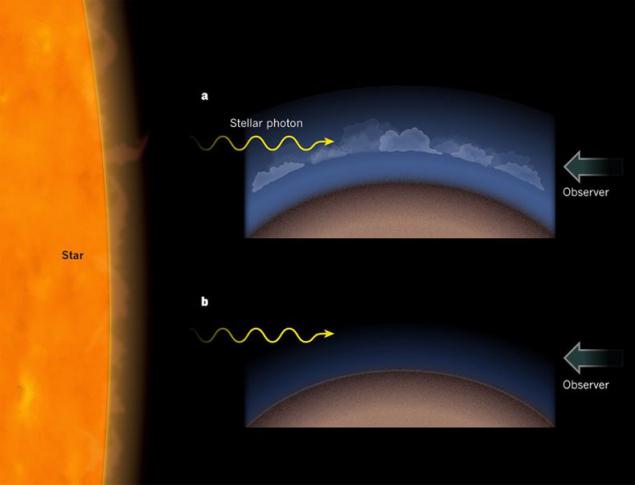
Image credit: Julianne Moses, Nature, 505, 31-32 (02 January 2014).
4) We break the record for the smallest exoplanet with water in the atmosphere
What you have already decided that in this list there will be no positive? The reality is that we only started to look for planets in the Kepler data, especially including the planet sizes from supertall to mininature. Usually this means worlds with cores with a solid surface, comparable in size with the Ground or slightly higher, with a hydrogen-helium envelope around them. In many cases, in the atmospheres of such worlds also come across some very interesting molecules, many of which we can find, seeing their absorption lines in the light of the parent star.
It is easiest to find big planets in young stars, and study the atmospheres of small planets is easier in smaller stars. It is still very hard to find water on the planet, like the earth, a star like the sun, but in this case we can study the Jupiter, and the smaller stars planets the size of Neptune. There is a technology through which you can find a mini-Neptune red dwarf of low mass and if you look at her limb (and will help us good luck) — then you can try to expect the discovery of the smallest planet with water in the atmosphere.

Image credit: Caltech/MIT/LIGO Laboratory.
5) Advanced LIGO will give the first applicant to the name of gravity waves.
Another very cool feature is the discovery of gravitational waves by the method of direct observation. This is one of the remaining as yet unconfirmed predictions of General Theory of Relativity. We are almost sure that such ripples of space-time must exist. We are already seeing close pair of neutron stars, and, according to General relativity, the constant contraction of their orbits speaks of the radiation of gravitational waves. But until we confirm this fact by direct observation, we cannot say.
Until this year, such technology simply did not exist. But with the advent of LIGO in September 2015 we need to collect enough data to hope for the confirmation of gravitational waves by the end of next year. Reflecting the laser beams by mirrors placed at great distances, we must obtain sufficient sensitivity for measurement in the space between the mirrors of gravitational waves. Of course, a little presumptuous of me to predict such a discovery immediately in the year following the launch of the new technology, but I'm such a fan of this, I put it on 2016.
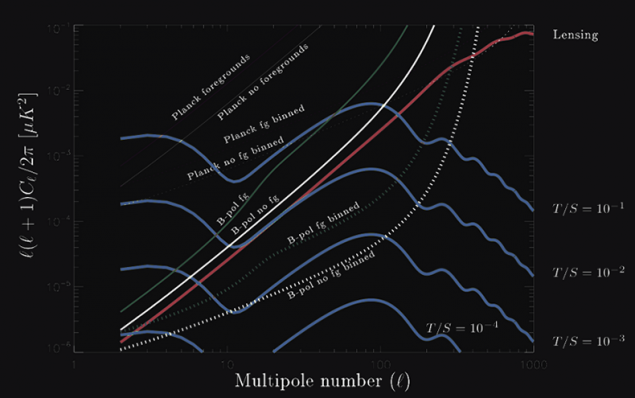
Image credit: Planck science team.
6) But gravitational waves from the Big Bang still does not detect in 2016
Last year the BICEP2 team gave a great rustle, announcing the discovery of gravitational waves left over from the Big Bang. Monumental discovery for many reasons, one of which fits perfectly into the model of Chaotic Inflation was developed by Andrei Linde (Andrei Linde) and completely contrary to other models — the "New inflation" Albrecht and Steinhard and also the Linda, according to which should be huge, really huge gravitational waves — one of the biggest that can allow for a variety of inflationary models
But upon receipt of the data, Planck, POLARBEAR, and BICEP2, these waves were imposed new restrictions, which began to conflict with chaotic models. I think that these gravitational waves not only will surface in 2016, but the limit will increase so that will make a chaotic model is unlikely. And then Linda with his graduate students and cooperating organizations will not come to an agreement.
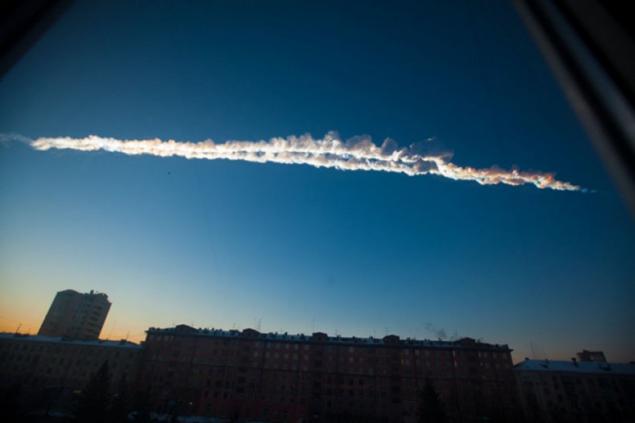
Image credit: Yekaterina Pustynnikova / Associated Press the trail of a meteor over Chelyabinsk, Russia, 2013.
7) Someone will again begin to speculate on the big asteroid flying by Earth. Any asteroid near the Earth will not appear.
We are tired of people who shout as usual "wolf! wolf!" in attempts to obtain funding for their investment in low probability and high impact risks? Perhaps, among them — an example of the entire domain of "protection from asteroids". Yes, in fact, are to two drops of "normal" asteroids, in which there is no destruction or victims, and who are — at worst — more than a flood or a tornado.
The collision with the formation of craters, or pose a threat to the cities, dangerous flights of large, kilometer asteroids are incredibly rare (a reasonable definition of what distance the danger from Ground) — despite all that you hear. Every year history repeats itself in the series — "OH, NO!!" the asteroid's coming to us, that is, we should expect that similar will be next year. I also predict that his size is exaggerated and he does not pose any danger. However, I could be wrong, there is such a lottery, sometimes you win — or, in our case, lose, and have to complete.
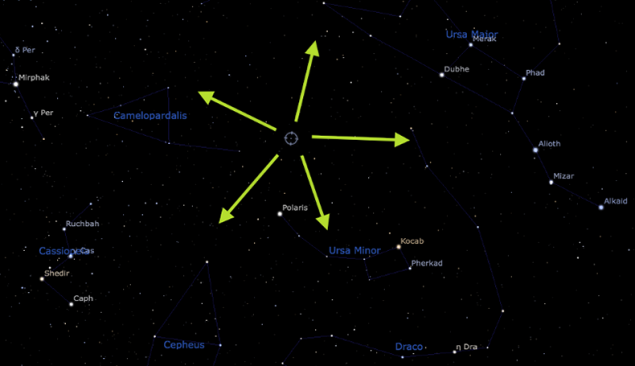
Image credit: I free software Stellarium, via stellarium.org/.
8) Giraffey (garapata?) — the latest meteor shower in Earth's history — will again be a disappointment
But it won't last forever! In 2012, the comet 209P/Linear was a close rendezvous with Jupiter, which sent her into the Solar System. In 2014, she was only a few millions km from the Earth, dragging a small tail of dust and debris that led to the first meteor stream in the constellation of the Giraffe, which was a big disappointment, giving only 5-10 meteors per hour with a peak of 23-24 March. There was virtually no meteors in 2015, they will not in 2016.
But the comet that creates them, is orbiting with a period of 5 years! Come back in 2019 to see it — perhaps when moving around the Sun, it will create much more garbage, which promises a much better chance to see something after 3 years!

A new object (U) as it was seen ALMA. Credit: R. Liseau, et al.
9) super-Earths in the outer Solar System? I bet that is an ordinary object belt Kuiper.
Last week the Internet went crazy from the fact that, as reported, was discovered the most distant object in the Solar system.
The title contained the term "super-earths" — or the planet is more Earth and less than Neptune at a distance of about 8 distances of Pluto from the Sun. But despite our most optimistic hopes, it is unlikely it is — planetologie objects of the Sun are in the plane of the Ecliptic and the orbit of this lies under a huge angle: as many as 42 degrees!
It is more likely that this object is in the outer Solar System, but much closer (at a distance of Sedna) and less Pluto. Other options — for example, to place him at a great distance and make a brown dwarf or even a star, even if they like you, is hardly possible — it would give significant emission in the infrared region, as we do not observe. Follow-up observations will help to better define the parameters of its orbit and then you can exactly say what it is. I bet that version of "super-earths" will disappear.
10) Nobel prize in physics in 2016 will be given for one of the following discoveries
— fermion condensates and other properties sverhkrupnyh atomic gases, Deborah Jean (Deborah Jin)
the tiny nanogenerators energy that work on the effect of piezoelectricity — the advent of electricity in the crystals under pressure — Zhon Lin Wong (Zhong Lin Wang)
— the discovery of exoplanets solar-type stars is likely to be divided between or William Boruca (William Borucki) (the"father" of the project "Kepler") or Alexander Wolfsheim (Aleksander Wolszczan), which opened the first planet of a pulsar in 1992, and Michel Mayor (Michel Mayor) and Didier Queloz (Queloz Didier), who opened the first planet from another star in 1995.
There is no reason to believe that you can't give three separate Nobel prize somewhere in this decade, but I bet next year it will be exoplanets. published
Author: Ethan Siegel
P. S. And remember, only by changing their consumption — together we change the world! ©
Join us in Facebook , Vkontakte, Odnoklassniki
Source: www.nebulacast.com/2015/12/10-2016.html
"The last words of the year belong to the last voice. Words new year await another voice." Thomas Eliot

2015 in science were very significant here for the following reasons:
— The large Hadron Collider (LHC) has reached the highest levels of energy in history
— scientists found evidence of water on the surface of Mars,
— confirmed one of the last great predictions of the Big Bang — the cosmic background radiation, neutrinos, and even measured its temperature,
— open a huge number of exoplanets that have further enhanced our expectations for the search for life in the Universe.
But we all know best, of course, in front, and 2016 promises even more new facts about the Universe. We can say with even more certainty that, if You read the various pseudo-scientific press, you will see a huge number of predictions that will never become reality!
And so, without superfluous noise and a dust, here in front of you 10 stories — my (approx. pens. — Ethan Siegel!) predictions of what we will see next year — with commentary, how likely is it that this event will occur in reality.

Image credit: X-ray: NASA/CXC/Univ of Hamburg/F. de Gasperin et al; Optical: SDSS; Radio: NRAO/VLA.
1. Experiments to detect dark matter will set a new distance record
Direct detection of dark matter — something like the "Holy Grail" of physicists. Several teams of scientists — for example, XENON, LUX, CDMS and ADMX are chasing dark matter or watching its collision with ordinary matter or trying to force her to interact with electromagnetic forces with the emission or annihilation of photons. Other, indirect methods have made it possible to observe dark matter — for example, in collisions of massive clusters of galaxies, but direct observations have not yet been.
Experiments like DAMA and CoGENT has detected an annual modulation in the number of interactions between particles. However, this result can be explained by the influence of certain other factors, not dark matter. While our experiments impose greater constraints on dark matter. I think that these restrictions will only increase and, most likely, we will not be able to directly detect dark matter in 2016м.

Image credit: E. Siegel, from his new book, Beyond The Galaxy.
2) Physics LHC will find at least 3 new particles... which are not particles!
The standard model of elementary particles is very good. Very very good. Too good — in the sense that when we study the results of collisions of particles, how they interact and decay, to explain what is happening to us required nothing more than the Standard model. And this is a problem for all extensions that currently exist, including the multiplicity of dimensions, supersymmetry, Technicolor or string theory. It is also a problem and dark matter if we ever wish to find in the lab.
In a perfect world we should open with a TANK of new fundamental particles. In particle physics the "gold standard" for discovery is 5σ, but the situation is so awful that it is reported on particles of 3.3 σ, 2.5 σ and 1.9 σ or even! Almost certainly this is not a real particle, and fluctuations. These kinds of messages we call "grasping at straws", this is evidence that we haven't found anything. I suppose at the LHC we won't find anything new, but messages about discoveries will continue to appear as if they are real particles, not speculative results based on fantasies... at least three times next year!

Image credit: NASA, via mars.nasa.gov/allaboutmars/extreme/quickfacts/.
3) In may 2016 Mars will come into opposition, and the media will again have a noise that he "size of the moon"
No, Mars will not be visible size of the moon — not now, not when it reaches opposition, never in the history of the Solar System. The reality is still incredibly interesting — Mars, unlike all the other planets, a huge difference in the distances of the different oppositions — from 56 million km in 2018 to 102 million km in 2027. But it is clear that it is not interesting for many people.
And all because the orbit of Mars is elliptical, which in combination with the orbit of the Earth leads to the fact that "close" the opposition seem to be 5 times brighter and at least 2 times more than "distant". But even the closest opposition will lead to the fact that the visible size of the disk of Mars in our sky will be about 25 seconds of arc (or 0.007 degrees), and the full Moon — size of 1800 arc seconds (or 0.5 degrees). To compare the apparent size of the Moon, Mars should be at a distance of 800 million km from Earth. It will never happen. But I foresee that such an idiotic rumor be full on the Internet.

Image credit: Julianne Moses, Nature, 505, 31-32 (02 January 2014).
4) We break the record for the smallest exoplanet with water in the atmosphere
What you have already decided that in this list there will be no positive? The reality is that we only started to look for planets in the Kepler data, especially including the planet sizes from supertall to mininature. Usually this means worlds with cores with a solid surface, comparable in size with the Ground or slightly higher, with a hydrogen-helium envelope around them. In many cases, in the atmospheres of such worlds also come across some very interesting molecules, many of which we can find, seeing their absorption lines in the light of the parent star.
It is easiest to find big planets in young stars, and study the atmospheres of small planets is easier in smaller stars. It is still very hard to find water on the planet, like the earth, a star like the sun, but in this case we can study the Jupiter, and the smaller stars planets the size of Neptune. There is a technology through which you can find a mini-Neptune red dwarf of low mass and if you look at her limb (and will help us good luck) — then you can try to expect the discovery of the smallest planet with water in the atmosphere.

Image credit: Caltech/MIT/LIGO Laboratory.
5) Advanced LIGO will give the first applicant to the name of gravity waves.
Another very cool feature is the discovery of gravitational waves by the method of direct observation. This is one of the remaining as yet unconfirmed predictions of General Theory of Relativity. We are almost sure that such ripples of space-time must exist. We are already seeing close pair of neutron stars, and, according to General relativity, the constant contraction of their orbits speaks of the radiation of gravitational waves. But until we confirm this fact by direct observation, we cannot say.
Until this year, such technology simply did not exist. But with the advent of LIGO in September 2015 we need to collect enough data to hope for the confirmation of gravitational waves by the end of next year. Reflecting the laser beams by mirrors placed at great distances, we must obtain sufficient sensitivity for measurement in the space between the mirrors of gravitational waves. Of course, a little presumptuous of me to predict such a discovery immediately in the year following the launch of the new technology, but I'm such a fan of this, I put it on 2016.

Image credit: Planck science team.
6) But gravitational waves from the Big Bang still does not detect in 2016
Last year the BICEP2 team gave a great rustle, announcing the discovery of gravitational waves left over from the Big Bang. Monumental discovery for many reasons, one of which fits perfectly into the model of Chaotic Inflation was developed by Andrei Linde (Andrei Linde) and completely contrary to other models — the "New inflation" Albrecht and Steinhard and also the Linda, according to which should be huge, really huge gravitational waves — one of the biggest that can allow for a variety of inflationary models
But upon receipt of the data, Planck, POLARBEAR, and BICEP2, these waves were imposed new restrictions, which began to conflict with chaotic models. I think that these gravitational waves not only will surface in 2016, but the limit will increase so that will make a chaotic model is unlikely. And then Linda with his graduate students and cooperating organizations will not come to an agreement.

Image credit: Yekaterina Pustynnikova / Associated Press the trail of a meteor over Chelyabinsk, Russia, 2013.
7) Someone will again begin to speculate on the big asteroid flying by Earth. Any asteroid near the Earth will not appear.
We are tired of people who shout as usual "wolf! wolf!" in attempts to obtain funding for their investment in low probability and high impact risks? Perhaps, among them — an example of the entire domain of "protection from asteroids". Yes, in fact, are to two drops of "normal" asteroids, in which there is no destruction or victims, and who are — at worst — more than a flood or a tornado.
The collision with the formation of craters, or pose a threat to the cities, dangerous flights of large, kilometer asteroids are incredibly rare (a reasonable definition of what distance the danger from Ground) — despite all that you hear. Every year history repeats itself in the series — "OH, NO!!" the asteroid's coming to us, that is, we should expect that similar will be next year. I also predict that his size is exaggerated and he does not pose any danger. However, I could be wrong, there is such a lottery, sometimes you win — or, in our case, lose, and have to complete.

Image credit: I free software Stellarium, via stellarium.org/.
8) Giraffey (garapata?) — the latest meteor shower in Earth's history — will again be a disappointment
But it won't last forever! In 2012, the comet 209P/Linear was a close rendezvous with Jupiter, which sent her into the Solar System. In 2014, she was only a few millions km from the Earth, dragging a small tail of dust and debris that led to the first meteor stream in the constellation of the Giraffe, which was a big disappointment, giving only 5-10 meteors per hour with a peak of 23-24 March. There was virtually no meteors in 2015, they will not in 2016.
But the comet that creates them, is orbiting with a period of 5 years! Come back in 2019 to see it — perhaps when moving around the Sun, it will create much more garbage, which promises a much better chance to see something after 3 years!

A new object (U) as it was seen ALMA. Credit: R. Liseau, et al.
9) super-Earths in the outer Solar System? I bet that is an ordinary object belt Kuiper.
Last week the Internet went crazy from the fact that, as reported, was discovered the most distant object in the Solar system.
The title contained the term "super-earths" — or the planet is more Earth and less than Neptune at a distance of about 8 distances of Pluto from the Sun. But despite our most optimistic hopes, it is unlikely it is — planetologie objects of the Sun are in the plane of the Ecliptic and the orbit of this lies under a huge angle: as many as 42 degrees!
It is more likely that this object is in the outer Solar System, but much closer (at a distance of Sedna) and less Pluto. Other options — for example, to place him at a great distance and make a brown dwarf or even a star, even if they like you, is hardly possible — it would give significant emission in the infrared region, as we do not observe. Follow-up observations will help to better define the parameters of its orbit and then you can exactly say what it is. I bet that version of "super-earths" will disappear.
10) Nobel prize in physics in 2016 will be given for one of the following discoveries
— fermion condensates and other properties sverhkrupnyh atomic gases, Deborah Jean (Deborah Jin)
the tiny nanogenerators energy that work on the effect of piezoelectricity — the advent of electricity in the crystals under pressure — Zhon Lin Wong (Zhong Lin Wang)
— the discovery of exoplanets solar-type stars is likely to be divided between or William Boruca (William Borucki) (the"father" of the project "Kepler") or Alexander Wolfsheim (Aleksander Wolszczan), which opened the first planet of a pulsar in 1992, and Michel Mayor (Michel Mayor) and Didier Queloz (Queloz Didier), who opened the first planet from another star in 1995.
There is no reason to believe that you can't give three separate Nobel prize somewhere in this decade, but I bet next year it will be exoplanets. published
Author: Ethan Siegel
P. S. And remember, only by changing their consumption — together we change the world! ©
Join us in Facebook , Vkontakte, Odnoklassniki
Source: www.nebulacast.com/2015/12/10-2016.html






















